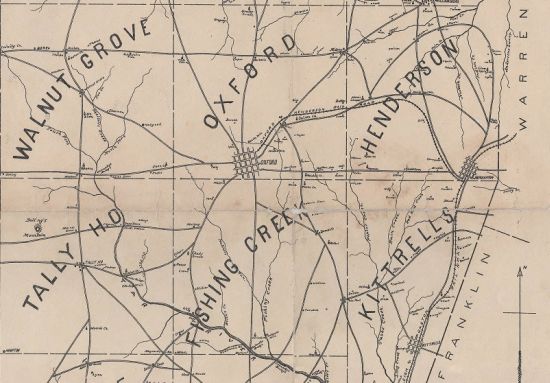Granville's 1858 Fair Had Regional Impact
The Granville County Agricultural Society held a county fair in Henderson, on October 13 and 14, 1858, more than twenty years before the creation of Vance County from portions of Franklin, Granville, and Warren counties. This successful event reflected a growing commitment in North Carolina to improving agricultural practices.
Its location in Henderson, a fledgling tobacco town on the Raleigh & Gaston Railroad, points toward a desire on the part of the organizers to draw participation from counties throughout the Upper Tar River region, including Franklin, Warren, and Nash.

Portion of Map of Granville County, North Carolina (1880), by T. C. Harris, courtesy of the North Carolina Collection, University of North Carolina at Chapel Hill.
Partly because the fertility of farmland had been exhausted, many people left North Carolina during the early nineteenth century, but the 1850s brought strong interest in scientific farming techniques. The North Carolina Agricultural Society was established in Raleigh in 1852, and its leaders sponsored the first State Fair the following year. Several farm journals spread information about the importance of crop rotation, fertilization, proper plowing, and other progressive measures. Counties and even localities formed their own agricultural societies.
This trend was important to the Upper Tar River region, because agriculture was its lifeblood. Whereas slaves constituted approximately a third of the population of North Carolina, they had a stronger presence in Franklin, Granville, and Warren counties. In 1860 they comprised fifty, forty-seven, and sixty-six percent, respectively, of the population of these counties.
Tobacco played a key role in the regional economy. In 1859 the farmers of both Granville and Warren counties produced more than six million pounds of the golden leaf. Franklin County's farmers grew two staple crops, harvesting 1,700,000 pounds of tobacco and 2,673 bales of cotton in 1859.
The editor of the Warrenton News covered the Granville County fair, arriving in Henderson on a "handsome" coach of the Raleigh & Gaston Railroad. According to a reprinted account in the Weekly Raleigh Register, the fairgrounds were located a half mile from the town. "A spacious Hall occupies the centre of the grounds," he said, "and the sheds for the exhibition of live stock being in the far part of the enclosure, there is left a large space for the exhibition of agricultural implements, and an open course for the trial of the speed of horses." The editor quickly encountered W. H. Rowland, the secretary of the event, busily arranging the exhibits. (According to the 1860 census, W. H. Rowland, of Hilliardston, in northern Nash County, was a thirty-seven-year-old merchant.)
Women had proudly displayed the fruits of their domestic labors. Counterpanes and "patchwork" quilts were hung for all to see. Table cloths, an embroidered rug, and many articles of clothing, including Miss Lucy C. Foster's black silk apron, also impressed the editor.
Men brought noteworthy farm products. A. J. Rogers of Warren County exhibited a stalk of corn containing six ears, and a number of farmers offered "splendid specimens" of tobacco. John J. Wyche showed "nine varieties of sugar cane, a pie melon 22 lbs weight, and fifteen varieties of strawberry plants." Also on display were preserved fruits, cordials, and homemade wines.
Agricultural implements caught the attention of many who attended the fair. Among them was a patent plough made by P. H. Smith, a cabinetmaker who lived in Franklin County. A cotton plough, with scraper, had been made by "Williams & Alston [of Warrenton], for Mr. McLean, of Louisburg."
Those in attendance were entertained by the widely respected African-American band of Frank Johnson, who "made the woods resound with their martial strains." This feature no doubt contributed to the success of the event.
Published in The Franklin Times on January 1, 2015.
Maury York is director of the Tar River Center for History and Culture at Louisburg College.

